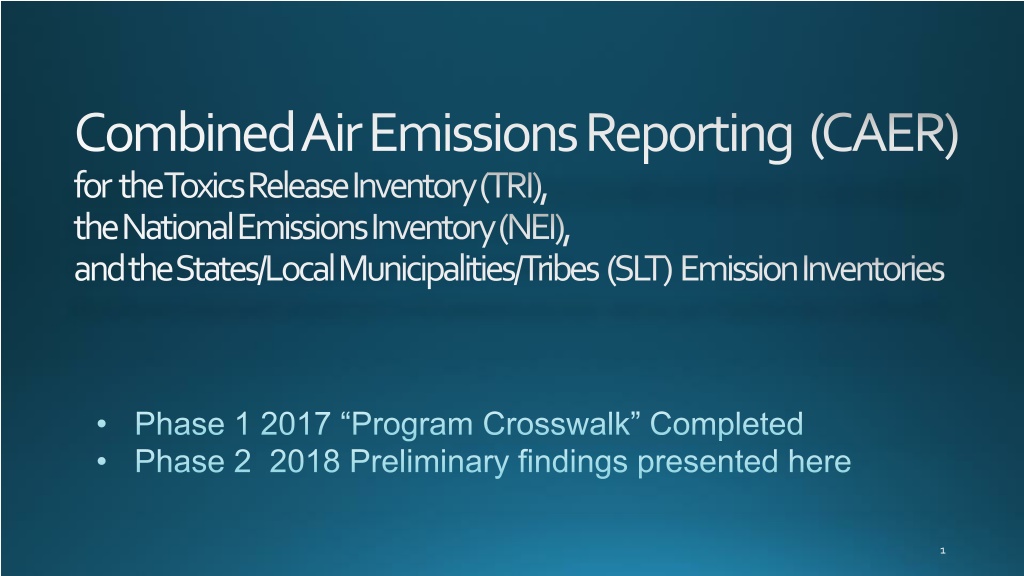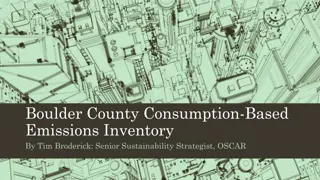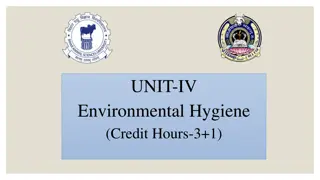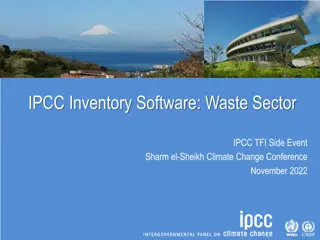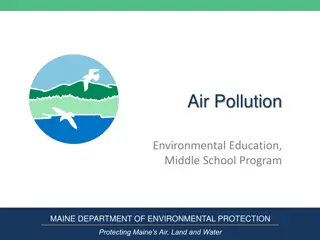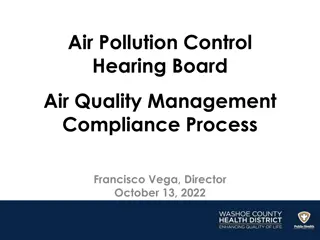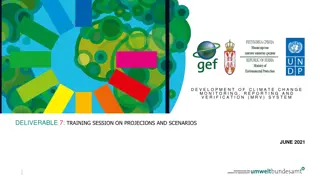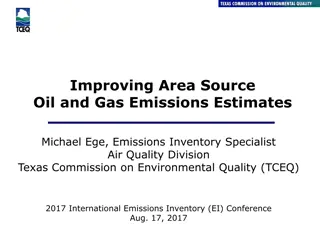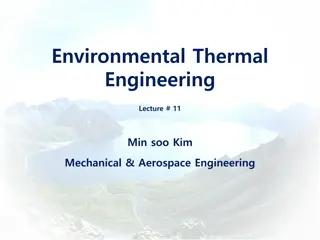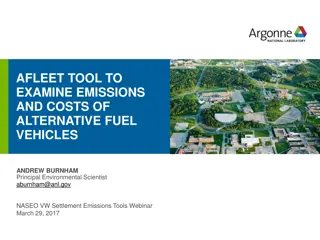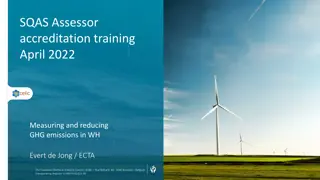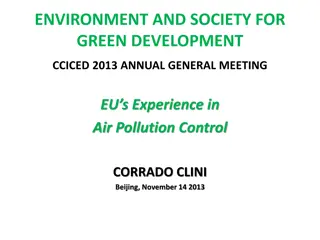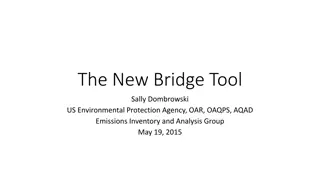Combined Air Emissions Reporting (CAER)
Lightweight foam concrete (LFC) is a versatile building material with varying densities, offering structural flexibility and insulation properties. This study investigates the thermal and mechanical characteristics of LFC at high temperatures, essential for predicting fire resistance and structural performance in construction.
Download Presentation

Please find below an Image/Link to download the presentation.
The content on the website is provided AS IS for your information and personal use only. It may not be sold, licensed, or shared on other websites without obtaining consent from the author. Download presentation by click this link. If you encounter any issues during the download, it is possible that the publisher has removed the file from their server.
E N D
Presentation Transcript
Combined Air Emissions Reporting (CAER) for the Toxics Release Inventory (TRI), the National Emissions Inventory (NEI), and the States/Local Municipalities/Tribes (SL T) Emission Inventories Phase 1 2017 Program Crosswalk Completed Phase 2 2018 Preliminary findings presented here 1
TRI/NEI/SLT Project: Purpose and Scope Purpose: Identify and evaluate consistencies and possible workflows for sharing emissions data between TRI, SLTs, and NEI. Scope-Phase 1: Identify differences in terminology used to define reporting requirements in each program. Identify pollutants that are common between the TRI and NEI, and specify how they relate to each other if there is not a one-to-one match. Research how states use TRI data for their NEI submissions. Team Members Phase 1: States: MN, SC EPA: Office of Pollution Prevention & Toxics (OPPT), Office of Air Quality Planning & Standards (OAQPS), Office of Environmental Information (OEI) Environmental Council of the States (ECOS) 2
TRI/NEI/SLT Phase 1: Results and Findings NEI and TRI terms and requirements comparison TRI NEI Who reports the data to EPA The facility itself State, local, and tribal agencies as well as EPA Frequency of Reporting Annually Annual for largest sources only, every three years for all sources Industries covered TRI-covered sectors (e.g., manufacturing, waste management, metal mining, electric utilities) No restrictions based on industry sector Pollutants covered TRI-listed chemicals (generally chemicals that cause cancer or other chronic human health effects, acute human health effects, and/or environmental effects.) Criteria air pollutants and precursors required. Hazardous air pollutants submitted voluntarily by SLT, and estimated by EPA. 3
TRI/NEI/SLT Phase 1: Results and Findings cont d (2) Pollutant Crosswalk NEI: Criteria air pollutants & precursors (CAPs) Ammonia, Lead, VOC, PM2.5, PM10, NOx, CO, SO2 187 hazardous air pollutants (HAPs) TRI: 2 of the CAPs: lead (which is both a HAP and CAP) and ammonia Almost all (about 96%) of the 187 HAPs In all, 692 chemicals and chemical categories TRI Chemicals and Chemical Categories (692) NEI Pollutants (8 CAPs, 187 HAPs) 4
TRI/NEI/SLT Phase 1: Results and Findings cont d (3) Pollutant Crosswalk TRI pollutants to NEI pollutants and vice versa Identified overlap in categories of chemicals Discovered and corrected issue with NEI glycol ethers 5
TRI/NEI/SLT Phase 1: Results and Findings cont d (4) EPA s Substance Registry Services (SRS) Pollutant Crosswalk Original posted in Sept, update posted in April Use pollutant crosswalk to update EPA s Substance Registry Services (SRS) 6
TRI/NEI/SLT Phase 1: Results and Findings cont d (5) Survey Three states use TRI data for their EI submission: Illinois, Minnesota, and Indiana Illinois and Minnesota use similar approach and incorporate TRI data into EI submission. Indiana does not include TRI data in submission, but uses it to inform what they submit. EPA also answered survey on how TRI is incorporated into the NEI TRI data is incorporated by EPA after the Air Emissions Reporting Requirement (AERR) deadline States and EPA report TRI data using the engineering judgement calculation method code 7
Final report and pollutant crosswalk at https://www.epa.gov/e-enterprise/product-design-team CAER webinar - https://www.youtube.com/watch?v=6r_elMUTMfY 8
TRI/NEI/SLT Project: Phase 2 Scope: Quantify differences in emissions (TRI and NEI data for 2014) Explore reasons for differences between reporting data Research cross-program data sharing and recommendations Develop comparisons and crosswalks for emission estimation method codes and control/treatment codes between NEI and TRI Team Members: States: MN, SC, MI, GA EPA: Office of Pollution Prevention & Toxics (OPPT), Office of Air Quality Planning & Standards (OAQPS), Office of Environmental Information (OEI) Environmental Council of the States (ECOS) 9
Phase 2: Metrics- 2014 NEI & 2014 TRI 66,000 NEI stationary facilities; 20,000 TRI facilities 24,000 NEI stationary facilities with potential overlapping NAICS and at least one overlapping pollutant At least 10,000 of these are in TRI (based on the EIS-to-TRI id matching) Of the available TRI emissions that match NEI pollutants, ~97% are loaded into EIS Emissions from 6,534 TRI facilities were used for gap-filling for at least one pollutant DRAFT -- PRELIMINARY FINDINGS. DO NOT QUOTE OR CITE. 10
Phase 2: 2014 NEI compared to 2014 TRI SLT Estimates Only Most of the estimates (facility level) are within 10% of each other TRI to NEI emissions ratio Less than 0.5 0.5 <0.9 0.9 <1.1 1.1 2 Greater than 2 Total Observations Count of estimates 1,478 1,450 6,788 2,178 3,003 14,780 11 DRAFT -- PRELIMINARY FINDINGS. DO NOT QUOTE OR CITE.
How do emissions compare by State SLT Estimates Only Distribution of TRI-to-NEI ratio bins by State Number of data points compared shown above each bar . 5 518 254 91 223 117 48 52 324 53 27 418 36 1113 524 275 4801090 11 53 87 447 504 409 264 15 562 63 170 11 349 37 9 317 676 189 12 719 5 44 487 385 2150 30 179 11 137 519 309 89 12 DRAFT -- PRELIMINARY FINDINGS. DO NOT QUOTE OR CITE
Magnitude of TRI/NEI ratios SLT Estimates Only For some facilities, TRI emissions may be 100 or more times greater than NEI Number of data points (facility-pollutant combinations) 75th percentile max 1e5 90th percentile 2000 1500 1000 500 10,000 TRI/NEI Ratio 1000 100 10 1 0.1 13 DRAFT -- PRELIMINARY FINDINGS. DO NOT QUOTE OR CITE.
Why are TRI/NEI emissions different? If SLT reports part of the facility s emissions for a pollutant, but not all, then NEI doesn t use TRI data and therefore NEI has incomplete emissions Sometimes NEI has data TRI does not (e.g., facility/chemical does not meet TRI reporting requirement) Additional explanations coming with case studies DRAFT -- PRELIMINARY FINDINGS. DO NOT QUOTE OR CITE. 14
Code cross-walks TRI has some of the same basis of estimate codes as NEI calculation method codes Continuous emissions monitoring Source test Material balance TRI has fewer codes (just one emission factor code Published Emission Factor compared to what is in the NEI) Developed Best Fit code cross-walk TRI treatment codes are generally broader than NEI control measure codes Scrubber, electrostatic precipitator TRI treatment codes are not just for air streams DRAFT -- PRELIMINARY FINDINGS. DO NOT QUOTE OR CITE. 15
Phase 2 next steps Continue with reporting codes cross-walks Complete case studies on why emissions are different Complete document on the current sharing of data for QA Recommendations for using and matching data in the combined form If you have any experiences/thoughts on any aspects of this project please contact us! (strum.madeleine@epa.gov) DRAFT -- PRELIMINARY FINDINGS. DO NOT QUOTE OR CITE. 16
